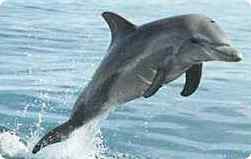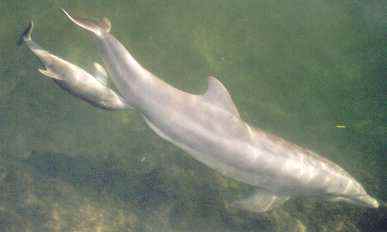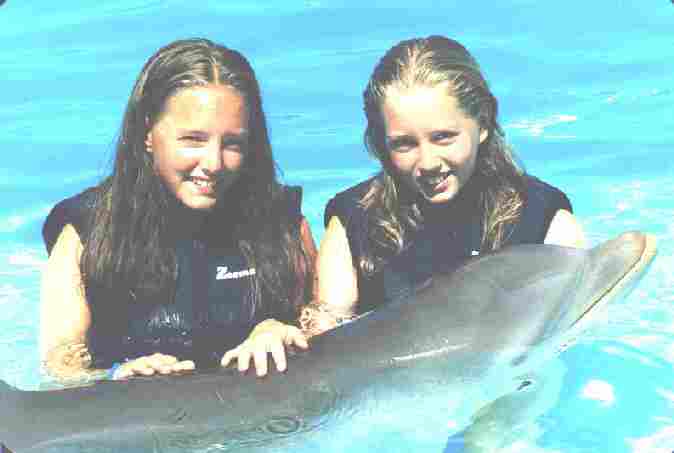|
DOLPHINS DOLPHINS | SHARKS | WHALES
|
|||||||||||||||||||||||
|
HOME | BIOLOGY | BOOKS | FILMS | GEOGRAPHY | HISTORY | INDEX | INVESTORS | MUSIC | NEWS | SOLAR BOATS | SPORT |
|||||||||||||||||||||||
|
DOLPHINS SYMBOLISE FREEDOM, JOY, GRACE and SERENITY the WORLD OVER.
ABOUT DOLPHINS
Dolphins are warm blooded mammals like man. Unlike fish, they give birth to one baby calf at a time. At birth a bottlenose dolphin calf is about 90-130cms long and will grow to approx. 4m, living up to 40 years. They are highly sociable animals, living in groups called pods, with dolphins from other pods interacting with each other occasionally. The dolphin is beautifully adapted for their life in the ocean
Dolphins use their powerful tail flukes in an up and down motion to move through the water. They also use their tails when hunting, hitting a flinging fish up into the air with their tail, stunning it, then scooping the fish up when it falls back into the water. A dolphin slapping its tail on the water in the wild may be a sign of annoyance, or a warning to other dolphins of danger. Their tail muscles are extremely powerful powerful allowing them to stand upright on their tail fin and propel themselves forward - walk on water.
Their pectoral flippers are used to steer them through the water, and they also use them to stroke one another, increasing the social bond between them. Dolphin "friends" may swim along face to face touching flippers. Dolphins that appear to be closely bonded may swim in synchrony, twisting, turning and swimming in perfect harmony together. Their teeth are interlocking rows of conical pegs, suitable for holding slippery fish. They eat their fish whole, head first. In the wild an open mouth is a sign of aggression, as is head nodding. A sign of greater aggression is violent jaw clapping.
Dolphins are able to dive to great depths, and also leap to great heights. They may leap to avoid predators or to show how powerful they are to females at mating time. Noisy splashing jumps may also be used to herd fish. Bottlenose dolphins can dive to depths of over 1,640 ft (500m).
Dolphins carry their young longer than humans, for about 12 months. The newborn emerges tail first and may suckle for up to 4 years. The baby will however stay with its mother for between 3-6 years, during which time it learns all about feeding techniques, social interaction and group foraging. Females are likely to stay within the family pod with their mother and sisters, though males will leave and form associations with other males. Dolphins have defined home ranges, an area in which they will roam and feed.
Though dolphins live in small groups called pods, these pods can be quite fluid and dolphins can be seen interacting with dolphins from other pods from time to time. If another dolphin is drowning, other dolphins will come to it's aid, supporting it with their bodies so it's blowhole is above the water allowing it to breathe. Dolphins main predators are sharks and unfortunately man, through direct killing for food,netting, pollution, and fishing.
Dolphins spend a large part of their day
looking for food, or actually feeding. They may either hunt
alone, or together as a pod. They use their echolocation (sonar
system) to locate fish by sending out a stream of pulses and
clicks. Dolphins communicate with eachother by whistling or body
language. When a baby is first born, some dolphin research
suggests a mother dolphin will whistle to it constantly,
imprinting her sound on the baby so it will recognize her, and
the baby learns to develop its own signature whistle. It is
thought that each dolphin has its own individual signature
whistle, just like a name.
THE FUTURE
In Australia and several other countries it is now illegal to catch or import any more dolphins for captivity, and standards of care and housing are high. One day we hope no dolphins anywhere around the world will ever have to live in very small barren concrete tanks without proper care again. There are also many opportunities to view dolphins in the wild now, in the ocean, without keeping the dolphins in small concrete tanks. Many people look to a future of coastal marine reserves rather than concrete tanks. Here, the dolphins could be free to come and go as they pleased, choosing whether they wanted to make contact with humans or not. Instead of performances for food, the dolphins would not need to perform. Humans could observe the dolphins in their natural environment, carrying out natural behaviors, not under cue of a human. Regulations would ensure the dolphins were not harmed or stressed by humans.
DAVE THE DOLPHIN - Sandgate, Kent
No more concrete prisons - www.dolphins.com
Natural History Learn about the range, behavior, and life span of bottlenose dolphins as well as other members of the delphinid family.
Anatomy See labeled body parts of a dolphin inside and out on a detailed diagram.
Physiology Find out how dolphins have adapted their bodies to the harsh ocean. Descriptions of dolphin organs and biological systems.
Sea
Lion Fact Sheet
Manatee
Fact Sheet
Manatee
Conservation
Conservation Endangered Species Survey a sample of endangered whale species and efforts being made to help them
Threats to Whales and Dolphins Humans have created many dangers for marine mammals including pollution, whaling, and some fishing methods. Study some of the biggest threats.
Personal Solutions Become a marine mammal conservationist and learn how to protect the environment we all share
Dolphin Assisted Therapy
At Dolphin Research Center Investigate the therapy programs and special needs sessions offered at Dolphin Research Center. This page includes past case studies.
Research
At Dolphin Research Center Research is our middle name. Look into the various projects we have studied throughout our history in addition to ongoing projects.
Current Research Study the current research projects happening at Dolphin Research Center
Training
At Dolphin Research Center Discover how and why we train dolphins and sea lions at Dolphin Research Center, including details of our methods.
Training Careers Become a marine mammal trainer by learning how to follow the training career path.
Career Information
Careers at Dolphin Research Center
Marine Mammal Law
Relevant
Legislation
Stranding
Dolphin
Research Center's Stranding Experience
whale-art | action-alerts | defender-awards | your-comments | discover-whales | events-calendar | faq | fighting-fund | photo-gallery | government | history | join | kids-pages | links | members-pages | news-archive | news-flash | published | stories-views | subscribe | whale-watching
More
Web Links Here are a few more of the thousands of websites that we think you'll find interesting.
For more information about marine mammals:
http://ammpa.org/
For more information about Marine Conservation:
http://www.nmfs.noaa.gov/prot_res/MMWatch/MMViewing.html
Visit this site to learn more about threats to wild dolphins from human interaction
This site offers links to every imaginable marine conservation related web site.
National Oceanic and Atmospheric Administrationís site dedicated to the Year of The Ocean. Excellent source of information on the importance of our marine resources.
Home page of the governmental watchdog organization responsible for monitoring the status of marine mammals.
CMC is an excellent source of factual, relevant information on all aspects of marine conservation.
Their web site is a fantastic resource on everything from fisheries and marine life to household toxins.
Dedicated to international wildlife conservation, WWF is a great resource for wildlife issues.
This is an intergovernmental organization monitoring the management of worldwide marine resources.
This organization is involved in great projects in all aspects of conservation. They have an excellent working group for small cetaceans.
Another excellent source of factual information. http://www.vims.edu/bridge/summer.html
The Bridge is a resource for marine science education, it covers everything from workshops and classes to educational materials. http://www.savethemanatee.org/
A great resource for information about Florida's endangered manatee.
Florida Keys: http://www.nhmi.org/ Located on Big Pine Key in the Florida Keys this institution offers a variety of marine education opportunities.
This office offers educational programs as well as printed materials on the Florida National Ocean Service.
http://www.gameznet.com.au/dolphins/animated.html
A taste for adventure capitalists
Solar Cola - a healthier alternative
|
|||||||||||||||||||||||
|
This
website
is Copyright © 1999 & 2015. The bird |
|||||||||||||||||||||||
|
AUTOMOTIVE | BLUEPLANET | ELECTRIC CARS | ELECTRIC CYCLES | SOLAR CARS |
|||||||||||||||||||||||


